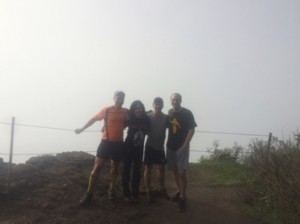By Ethan Struckmeyer
You wake up early, rubbing the sleep from your eyes. You begin to go over the plan you’ve prepared for the big moment. You put on the appropriate clothes and tie your shoes. You walk out the door ready to tackle the challenge ahead of you. Soon, nerves creep in and you start to wonder if you’re really as prepared as you thought you were. But once you’ve started you’re reminded that you’ve got this. After all, you’ve been preparing for this for quite some time. Finally, after it’s all over, you can leave feeling like you’ve accomplished something important.
 This is the process navigated by my Community Planning Workshop team and I as we set out to meet with our client in the land of trees, cheese, and ocean breeze – Tillamook County. It was our first in-person visit with county staff since our project started in January. The goal of the meeting was to gain a better understanding of what specific sections of their Development Code could be improved to better mitigate the risks to life and property caused by natural hazards in the area such as landslide, coastal erosion, flooding, and tsunami.
This is the process navigated by my Community Planning Workshop team and I as we set out to meet with our client in the land of trees, cheese, and ocean breeze – Tillamook County. It was our first in-person visit with county staff since our project started in January. The goal of the meeting was to gain a better understanding of what specific sections of their Development Code could be improved to better mitigate the risks to life and property caused by natural hazards in the area such as landslide, coastal erosion, flooding, and tsunami.
Similarly, this is also the process we navigated as we set out for a post-client meeting group run through the trails of Cape Lookout, along the coast of the Pacific Ocean. The 4.6 mile, out and back trail provided the perfect amount of challenge and scenic views as we debriefed our recently concluded client meeting.
At first read, you probably thought “I respectfully disagree with you, Ethan. How could you have followed the same process when client meetings and trail running are completely dissimilar?”
Well, thank you for asking.
When you think about it and begin to parse out the main aspects of each situation you will start to see the similarities – plan, practice, and execute.
Before heading into either situation, whether it’s going for a run or meeting with a client, you need to make a plan. How far can you run and where will you go? Can you run 4 miles without feeling like your lungs are on fire? What are the main objectives you hope to accomplish in your meeting? Do you have the right shoes?
After you’ve made your plan, you need to practice. How many times do you run in a week? Are you getting better at it? Do you know exactly what you’re going to present to the client? Are you knowledgeable enough to answer any questions your client might have on your topic? You don’t want to stumble. You might scuff your knee.
Now that you’ve set out your plan and you’ve been practicing, all you need to do is execute. Are you nervous you’ll make a mistake? Don’t be. You’ve planned for that. Keep calm, breathe, and you’ll get to the finish line.
Ethan Struckmayer
 Born, raised, and educated in Minnesota, I moved to Oregon in 2014 to serve in the Resource Assistance for Rural Environments (RARE) Americorps Program where I worked on land-use and long range planning for the cities of Donald and Gervais. I’m now in my first year studying to become a Master of Community and Regional Planning at the University of Oregon. You can usually find me playing disc golf, homebrewing, or watching a Green Bay Packers game.
Born, raised, and educated in Minnesota, I moved to Oregon in 2014 to serve in the Resource Assistance for Rural Environments (RARE) Americorps Program where I worked on land-use and long range planning for the cities of Donald and Gervais. I’m now in my first year studying to become a Master of Community and Regional Planning at the University of Oregon. You can usually find me playing disc golf, homebrewing, or watching a Green Bay Packers game.

